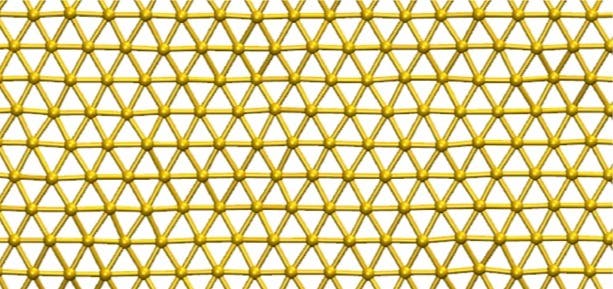Single-atom-thick gold (Goldene) opens doors to a clean-tech revolution
This innovative material possesses unique properties that hold immense potential for applications in clean energy production

Scientists at Linköping University, Sweden, have achieved a breakthrough in materials science by creating single-atom-thick sheets of gold, dubbed "goldene." This innovative material possesses unique properties that hold immense potential for applications in clean energy production, chemical processing, and more.
The significance of goldene lies in its departure from the traditional metallic behavior of gold. In its bulk form, gold boasts twelve nearest neighbors for each atom. However, when compressed into a single-atom layer, this number reduces to just six. This drastic change in atomic arrangement fundamentally alters gold's electronic properties, transforming it from a metal into a semiconductor.
"The extraordinary thing about extremely thin materials is that their properties change dramatically," explains Shun Kashiwaya, a researcher at Linköping University's Materials Design Division. "Similar to graphene, gold also undergoes this transformation. While bulk gold is a metal, a single-atom layer exhibits semiconducting behavior."
The path to goldene's discovery wasn't entirely straightforward. The researchers initially aimed to create a completely different material – an electrically conductive ceramic containing silicon sandwiched between titanium carbide layers. The gold was simply intended as a contact layer.
However, during the high-temperature processing, an unexpected phenomenon occurred. The silicon layer diffused out, replaced by gold atoms within the base material. This process, known as intercalation, resulted in the formation of titanium gold carbide.
For several years, the research team held the key to goldene without realizing it. The challenge lay in extracting the embedded gold as a separate, usable material. The answer, surprisingly, came from an ancient Japanese metalworking technique.
Related Stories:
Professor Lars Hultman, a thin film physics expert at Linköping University, stumbled upon a century-old method called Murakami's reagent.
Traditionally used in knife-making to remove carbon residue and alter the color of steel, this reagent offered a potential solution for extracting the gold from the titanium carbide matrix.
"Murakami's reagent wasn't a direct fit," says Kashiwaya. "I had to experiment with different concentrations and etching times – days, weeks, months. Our observations indicated that lower concentrations and longer etching durations yielded better results, but it still wasn't perfect."
Another crucial aspect of the process involved light sensitivity. The reaction with Murakami's reagent generates cyanide, which readily dissolves gold when exposed to light. To prevent this, the etching needed to occur in a dark environment.
The final hurdle was stabilizing the extracted gold sheets. To prevent curling and agglomeration, the researchers employed a surfactant – a long molecule that acts as a separator and stabilizer.
"The goldene sheets exist in a solution, similar to flakes in milk," explains Kashiwaya. "We then use a special 'sieve' to collect the gold and confirm its structure using electron microscopy. And yes, we were successful!"
Goldene's unique properties stem from the altered atomic arrangement. Each gold atom possesses only half the number of neighbors compared to bulk gold. This has significant implications for potential applications.
"The possibilities are vast," emphasizes Kashiwaya. "Goldene holds promise for CO2 conversion, hydrogen production catalysis, selective synthesis of valuable chemicals, water purification, and even advancements in communication technology."
Beyond the exciting potential for new technologies, goldene offers a compelling solution to resource scarcity. By utilizing gold in a single-atom layer format, the amount of precious metal required for various applications can be significantly reduced.
The Linköping University team is actively exploring further avenues. Their research focuses on replicating this success with other noble metals and identifying additional groundbreaking applications for goldene. This discovery, supported by a consortium of Swedish research funding institutions, opens doors for a more sustainable and technologically advanced future.
Research: Synthesis of goldene comprising single-atom layer gold, Shun Kashiwaya, Yuchen Shi, Jun Lu, Davide G. Sangiovanni, Grzegorz Greczynski, Martin Magnuson, Mike Andersson, Johanna Rosen, and Lars Hultman; Nature Synthesis.
For more science news stories check out our New Innovations section at The Brighter Side of News.
Note: Materials provided above by The Brighter Side of News. Content may be edited for style and length.
Like these kind of feel good stories? Get the Brighter Side of News' newsletter.



